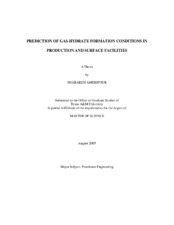| dc.description.abstract | Gas hydrates are a well-known problem in the oil and gas industry and cost millions of
dollars in production and transmission pipelines. To prevent this problem, it is important
to predict the temperature and pressure under which gas hydrates will form. Of the
thermodynamic models in the literature, only a couple can predict the hydrate-formation
temperature or pressure for complex systems including inhibitors.
I developed two simple correlations for calculating the hydrate-formation pressure or
temperature for single components or gas mixtures. These correlations are based on over
1,100 published data points of gas-hydrate formation temperatures and pressures with and
without inhibitors. The data include samples ranging from pure-hydrate formers such as
methane, ethane, propane, carbon dioxide and hydrogen sulfide to binary, ternary, and
natural gas mixtures. I used the Statistical Analysis Software (SAS) to find the best
correlations among variables such as specific gravity and pseudoreduced pressure and
temperature of gas mixtures, vapor pressure and liquid viscosity of water, and
concentrations of electrolytes and thermodynamic inhibitors.
These correlations are applicable to temperatures up to 90ºF and pressures up to 12,000
psi. I tested the capability of the correlations for aqueous solutions containing electrolytes
such as sodium, potassium, and calcium chlorides less than 20 wt% and inhibitors such as
methanol less than 20 wt%, ethylene glycol, triethylene glycol, and glycerol less than 40
wt%. The results show an average absolute percentage deviation of 15.93 in pressure and
an average absolute temperature difference of 2.97ºF. Portability and simplicity are other advantages of these correlations since they are
applicable even with a simple calculator. The results are in excellent agreement with the
experimental data in most cases and even better than the results from commercial
simulators in some cases. These correlations provide guidelines to help users forecast
gas-hydrate forming conditions for most systems of hydrate formers with and without
inhibitors and to design remediation schemes such as:
· Increasing the operating temperature by insulating the pipelines or applying heat.
· Decreasing the operating pressure when possible.
· Adding a required amount of appropriate inhibitor to reduce the hydrateformation
temperature and/or increase the hydrate-formation pressure. | en |


